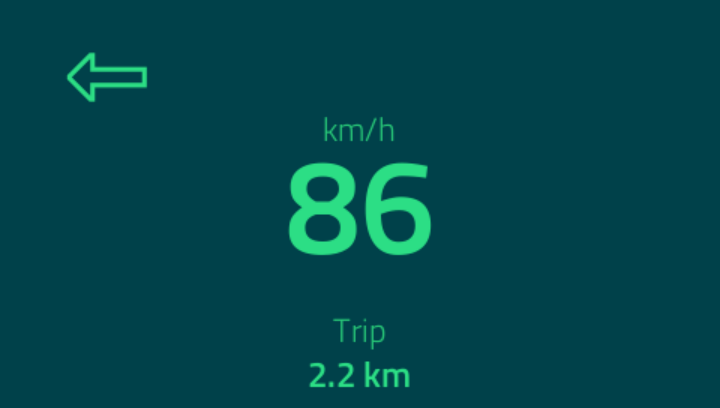C
Qt Quick Ultralite instrument_cluster Example
Demonstrates how to control user interface elements from a C application.
Overview
This example demonstrates how to control user interface elements from a C application.

Target platforms
Project structure
The instrument_cluster example consists of the following files:
src/VehicleStatus.cppsrc/VehicleStatus.hCMakeLists.txtmcu_instrument_cluster.qmlprojectinstrument_cluster.qml
The CMake project file contains a basic build script, instrument_cluster.qml which defines the application's UI. The project configuration is defined in mcu_instrument_cluster.qmlproject.
In addition to these files, the src/simulation folder contains a simple simulator to provide input data for the instrument cluster on non-AUTOSAR platforms:
src/simulation/baremetal/main.cppsrc/simulation/freertos/main.cppsrc/simulator.cppsrc/simulator.h
The fonts folder contains the font files of the application:
fonts/TitilliumWeb-Light.ttffonts/TitilliumWeb-SemiBold.ttf
CMake project file
Note: Simulation files are added only for non-AUTOSAR targets.
cmake_minimum_required (VERSION 3.21.1)
project(instrument_cluster VERSION 0.0.1 LANGUAGES C CXX ASM)
if (NOT TARGET Qul::Core)
find_package(Qul)
endif()
set(TARGET_SOURCES src/VehicleStatus.cpp)
set(INCLUDE_DIRECTORIES ${CMAKE_CURRENT_SOURCE_DIR}/src)
set(GENERATE_ENTRYPOINT_ARG "")
if(NOT QUL_PLATFORM MATCHES "autosar")
set(SIMULATOR_DIR src/simulation)
set(TARGET_SOURCES
${TARGET_SOURCES}
${SIMULATOR_DIR}/simulator.cpp
${SIMULATOR_DIR}/${QUL_OS_LOWERCASE}/main.cpp
)
set(INCLUDE_DIRECTORIES
${INCLUDE_DIRECTORIES}
${CMAKE_CURRENT_SOURCE_DIR}/src/simulation
)
else()
set(GENERATE_ENTRYPOINT_ARG GENERATE_ENTRYPOINT)
endif()
qul_add_target(instrument_cluster
${TARGET_SOURCES}
QML_PROJECT mcu_instrument_cluster.qmlproject
${GENERATE_ENTRYPOINT_ARG}
)
app_target_setup_os(instrument_cluster)
target_include_directories(instrument_cluster PRIVATE
${INCLUDE_DIRECTORIES}
)
if(NOT CMAKE_CROSSCOMPILING AND NOT WIN32)
add_custom_command(TARGET instrument_cluster
COMMAND strip instrument_cluster -o instrument_cluster.stripped
DEPENDS instrument_cluster)
endif()QmlProject file
import QmlProject 1.3
Project {
mainFile: "instrument_cluster.qml"
MCU.Config {
defaultFontFamily: "Titillium Web"
}
FontFiles {
files: [
"fonts/TitilliumWeb-Light.ttf",
"fonts/TitilliumWeb-SemiBold.ttf"
]
}
QmlFiles {
files: [
"instrument_cluster.qml"
]
}
InterfaceFiles {
files: ["src/VehicleStatus.h"]
}
}VehicleStatus singleton
The VehicleStatus singleton is responsible for storing the vehicle parameters for the user interface. It inherits from Qul::Singleton to expose the public signals and properties to QML. It also inherits from Qul::EventQueue to provide an event queue to trigger user interface update when the property values are changed.
...
Qul::Property<int> speed;
Qul::Property<double> tripMeter;
Qul::Signal<void(bool leftBlinkerState)> leftBlinkerStateChange;
Qul::Signal<void(bool rightBlinkerState)> rightBlinkerStateChange;
...The QML code accesses these values via VehicleStatus singleton:
...
Text {
id: speedometer
color: "#2CDE85"
anchors.centerIn: parent
font.weight: Font.DemiBold
font.pixelSize: 90
text: VehicleStatus.speed
}
...The repainting of the instrument cluster is triggered by using a dummy event queue. Event handling requires Qt Quick Ultralite engine to do an update.
... void qul_application_send_value_change_event() { VehicleStatus::instance().postEvent(true); } ...
The actual event handler does nothing:
...
void onEvent(const bool &value)
{
// Dummy event queue to trigger UI updates
(void) value;
}
...C linkage functions are exposed to the non-GUI code to control instrument cluster content:
... extern "C" { void qul_application_set_speed(int speed) { VehicleStatus::instance().speed.setValue(speed); } ...
AUTOSAR example
In an AUTOSAR project, the Qt Quick Ultralite Complex Device Driver calls the C linkage APIs as shown below:
#include "VehicleStatus.h"
...
// QUL Complex Device Driver Runnable with a periodic trigger
void Cdd_Qul_Update(void)
{
int changedValuesCount = 0;
static int previousSpeed = 0;
int speed;
// Read the speed value via the AUTOSAR Interface
// Rte_Read_Cdd_Qul_Speed(&speed);
if (speed != previousSpeed) {
changedValuesCount++;
qul_application_set_speed(speed);
previousSpeed = speed;
}
...
if (changedValuesCount > 0) {
// Send an event to trigger repainting of the UI
qul_application_send_value_change_event();
}
qul_update_engine(); // Calls Qul::Application::update()
}Files:
- instrument_cluster/CMakeLists.txt
- instrument_cluster/instrument_cluster.qml
- instrument_cluster/mcu_instrument_cluster.qmlproject
- instrument_cluster/src/VehicleStatus.cpp
- instrument_cluster/src/VehicleStatus.h
- instrument_cluster/src/simulation/baremetal/main.cpp
- instrument_cluster/src/simulation/simulator.cpp
- instrument_cluster/src/simulation/simulator.h
See also Integrating C++ code with QML.
Available under certain Qt licenses.
Find out more.

